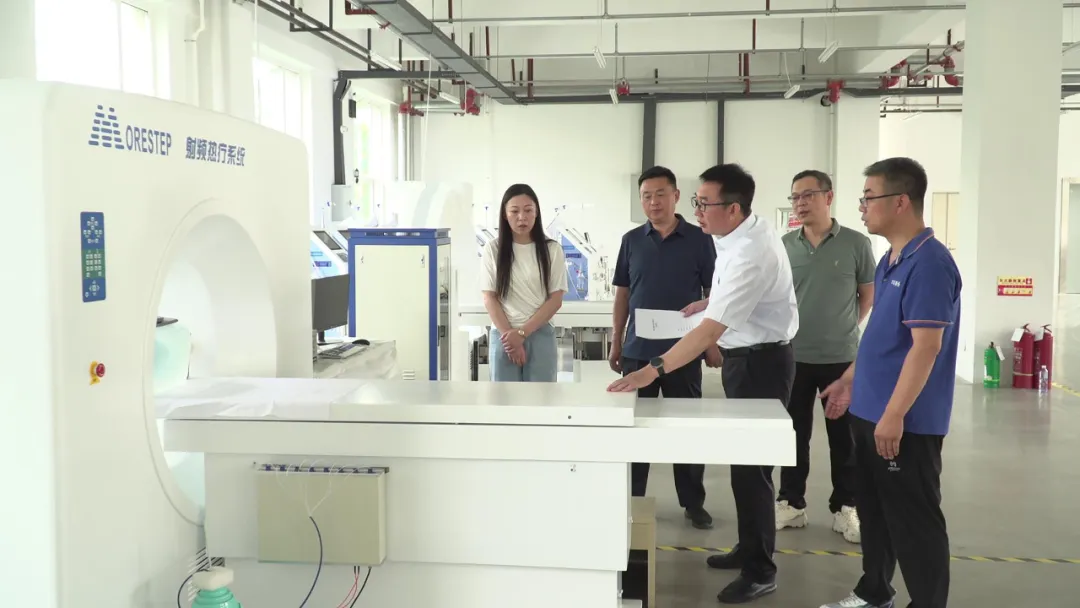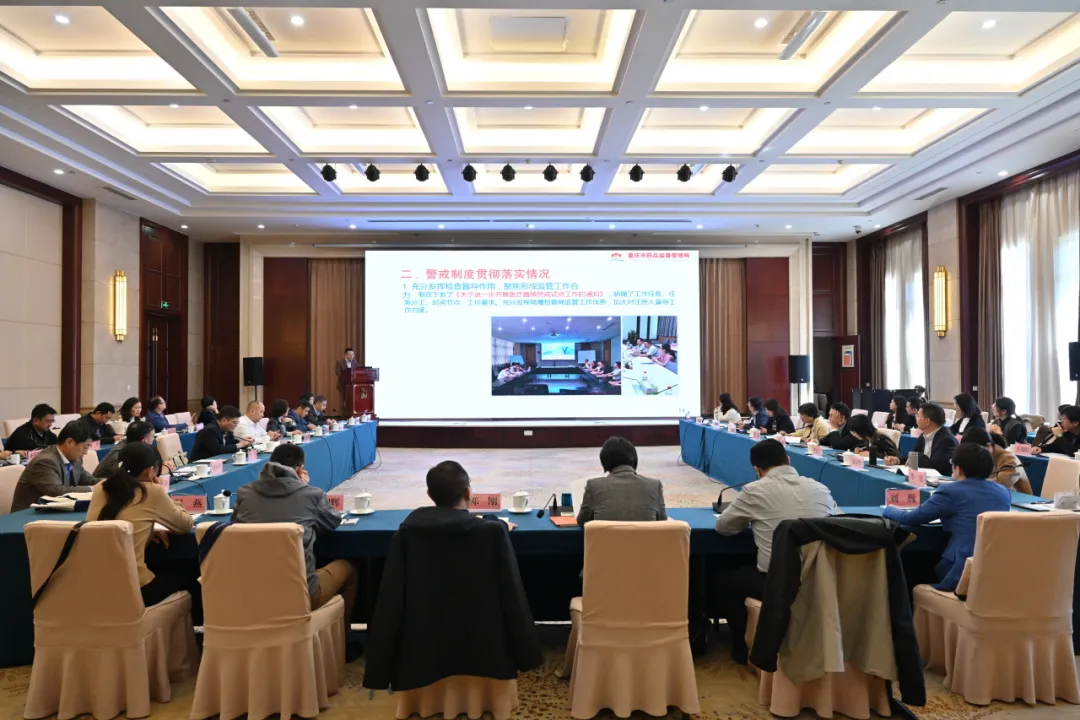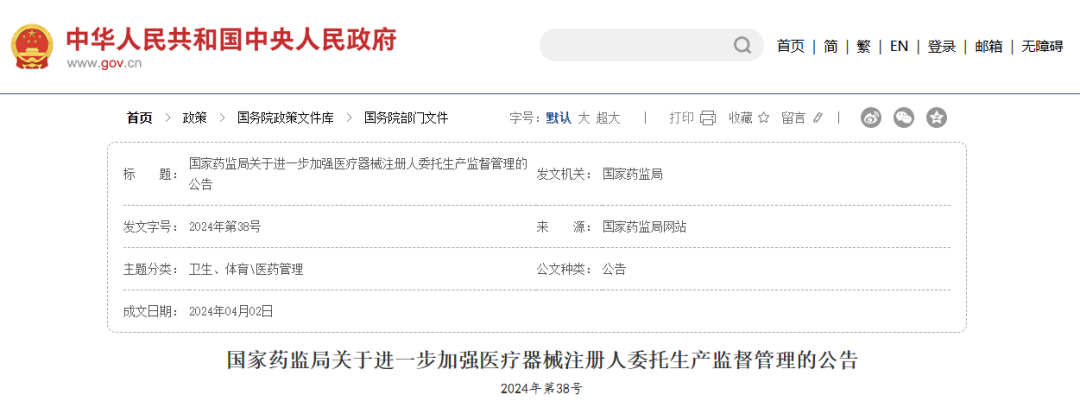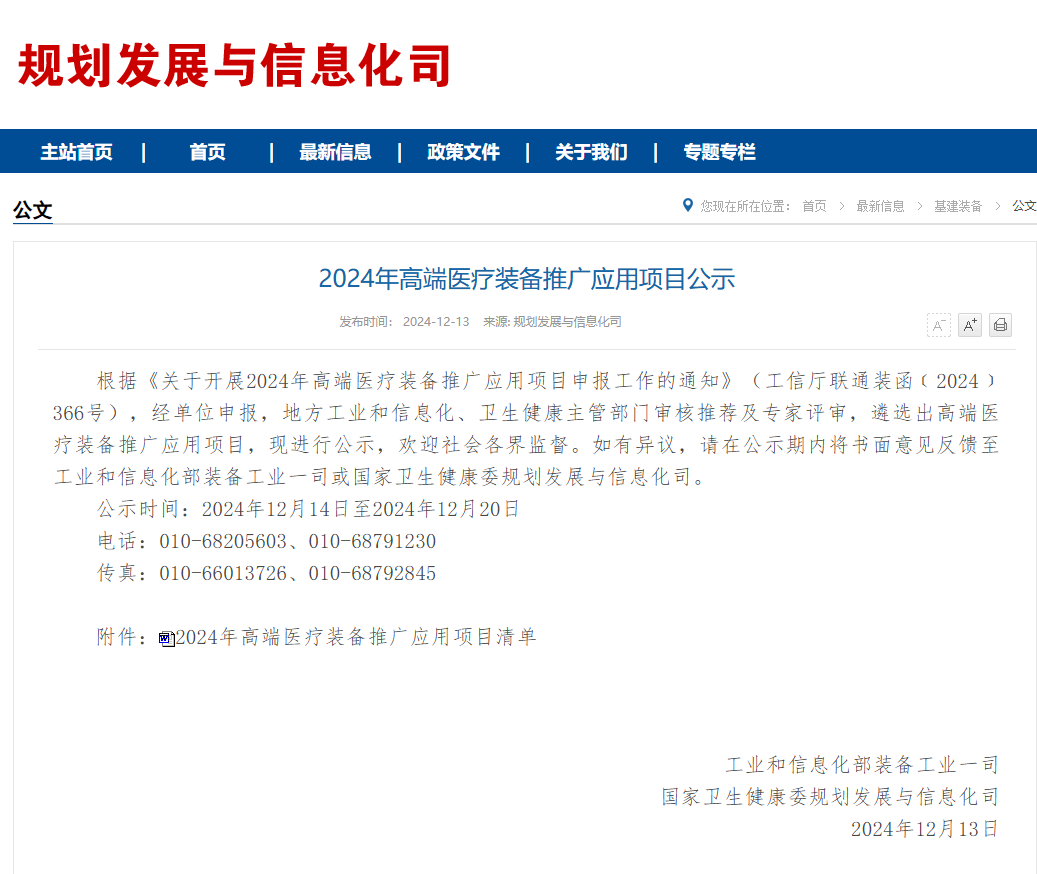Top Ten Hot Events in Medical Device Regulation for 2024
Release time:
2024-12-28

The year 2024 is coming to an end. This year, we have witnessed the development of medical device regulation: the initial form of the Medical Device Management Law of the People's Republic of China has emerged, the work of consolidating and enhancing medical device safety has continued to deepen, the number of approved innovative medical devices has reached a new high, and the standardization of medical devices has made new progress...
Next, let's take stockof the top ten highlights of medical device regulation in 2024, reviewing the development trajectory of the medical device industry over the past year and gaining insights into future industry trends.
1
Public consultation on the 'Draft for Comments on the Medical Device Management Law of the People's Republic of China'

On August 28, 2024, the National Medical Products Administration made the 'Draft for Comments on the Medical Device Management Law of the People's Republic of China' public, widely soliciting opinions and suggestions from all sectors of society. This draft consists of eleven chapters and 190 articles, covering all aspects of medical devices from research and development, production, operation to use, while also involving key aspects such as standard formulation, classification management, alert mechanisms, and recall procedures, marking the initial form of the first fundamental law in the field of medical device management in China.
On September 7, 2023, the legislative plan of the 14th National People's Congress Standing Committee was officially released, and the Medical Device Management Law was included, attracting much attention to its legislative process. In the nearly one year that followed, the National Medical Products Administration actively organized nearly 20 symposiums, gathering wisdom from various parties, deeply collecting and earnestly listening to voices and demands from different fields; collaborating with legislative bodies to conduct field research in local areas, accurately grasping the current state of industrial development, and sincerely listening to the industry's earnest expectations for improving the legal and regulatory system for medical device regulation; repeatedly convening special working meetings and concentrated revision meetings to conduct in-depth and detailed research and demonstration on key and difficult issues, continuously optimizing and improving the draft, fully demonstrating the unwavering determination of the National Medical Products Administration to lead with the rule of law and promote the medical device industry towards a new journey of high-quality development.
The transition of medical device management from administrative regulations to legal status is not merely an elevation of legal hierarchy, but also signifies a comprehensive optimization and upgrade in content. This will significantly enhance the systematic nature of medical device regulations and policies, markedly improve the unity and coordination of medical device regulation, and lay a solid foundation for the steady development of the entire industry. We look forward to the early official implementation of this new fundamental law for the industry, which will safeguard the vigorous development of the medical device industry and open a new chapter.
Related reading:Draft for Comments on the Medical Device Management Law of the People's Republic of China
2
The work of consolidating and enhancing medical device safety continues to deepen

The image showsOn July 15, 2024, staff from the Jilin Provincial Medical Products Administration, leading the work of consolidating and enhancing medical device safety, conducted risk hazard investigations at Maida Medical Device Co., Ltd., checking the compliance of the company's production quality management system.
In June 2023, the national medical product regulatory system fully launched the action to consolidate and enhance drug safety. During this action, local drug regulatory departments focused on the three key tasks of 'preventing risks, investigating cases, and enhancing capabilities', implementing precise measures, and introducing a series of effective initiatives, achieving remarkable results.
In the field of medical devices, local drug regulatory departments regard the work of consolidating and enhancing medical device safety as a core focus, continuously strengthening the dynamic supervision effectiveness of quality and safety throughout the entire lifecycle of medical devices, deeply investigating and effectively resolving various potential safety risks, and ensuring that the safety situation of medical devices remains stable and develops positively. In fact, carrying out the action to consolidate and enhance drug safety is not only a key move to continuously enhance drug regulatory capabilities but also an inevitable measure to safeguard the life and health of the people.
In recent years, the medical device industry has shown a vigorous development trend characterized by the integration of new technologies, new products, and new business models, which undoubtedly presents unprecedented challenges to medical device regulation. In response to this situation, drug regulatory departments at all levels have firmly grasped the opportunities brought by advancing the work of consolidating and enhancing medical device safety, boldly innovating regulatory mechanisms and methods, focusing on key varieties such as centralized procurement selections, sterile implants, and key enterprises entrusted with production, and comprehensively and deeply carrying out risk hazard investigations and rectification work; at the same time, continuously strengthening online monitoring efforts, increasing the intensity of case investigations, steadily advancing the process of regulatory capacity building, further optimizing risk consultation and problem resolution mechanisms, and severely cracking down on various illegal activities with strong measures. The strong measures with 'teeth' have built a solid defense line for medical device safety, effectively deterring illegal activities in the field of medical device safety, and genuinely enhancing the sense of safety and gain for the public during the use of medical devices, allowing the public to use various medical device products with more confidence and peace of mind.
3
The number of approved innovative medical devices has increasedby 65
with a total exceeding300

As ofDecember 25, 2024, the National Medical Products Administration has approved 315 innovative medical devices for market entry. Among them, 65 were approved in 2024, covering various fields such as high-end medical equipment, surgical robots, and artificial hearts.
Innovative medical devices represent a new quality of productive forces in the medical device field. In recent years, the National Medical Products Administration has conducted in-depth research on the development of the medical device industry.Addressing 'bottlenecks' and 'difficulties', continuously improving regulatory mechanisms, supporting and encouraging the innovative development of the medical device industry, and promoting the rapid market entry of innovative products to benefit patients. A review of the 315 approved innovative medical device products shows that the National Medical Products Administration adheres to a problem-oriented approach, focusing on supporting the research and development of innovative products in sub-sectors such as surgical robots, medical imaging, artificial intelligence, and biomaterials. The successful approval of these products not only provides patients with more treatment options but also effectively enhances the safety and success rate of clinical surgeries, better meeting the public's demand for high-level, high-quality medical devices.
4
The number of medical device standards has exceeded2000 items

The image showsOn November 19, 2024, the first annual meeting and standard approval meeting of the standardization technical unit for traditional Chinese medicine devices was held in Jinan, Shandong, summarizing the work of 2024 and discussing and approving the work plan for 2025, as well as reviewing the draft for three industry standards including 'Traditional Chinese Medicine Small Needle Knife'.
As ofBy the end of October 2024, the number of medical device standards in China has exceeded 2000, reaching 2011, including 284 national standards and 1727 industry standards, achieving full coverage of all professional technical fields of medical devices; at the same time, the consistency of China's medical device standards with international standards has reached over 90%, and the coverage, systematic nature, and international coordination of the standard system have been continuously improved, marking a new level in the standardization work of medical devices.
Medical device standards are an important technical support for the high-quality development of medical devices. In recent years, the National Medical Products Administration has continuously implemented action plans to improve medical device standards, organizing the revision and formulation of standards every year.About 100 medical device standards; international exchanges and cooperation have also deepened, participating in or leading the formulation and revision of 20 international medical device standards since 2021. The quantity and quality of standards have achieved a double improvement, and the "flower of standards" is in full bloom. Among them, the development of standards in high-end and innovative fields such as artificial intelligence medical devices and new biomedical materials is an important part of the medical device standard work. The release of relevant standards fills the gap in innovative field standards, providing scientific guidance for the research and development of innovative medical devices, and accelerating the construction of a medical device standard system oriented towards new quality productivity. All relevant parties should fully leverage the guiding, leading, and foundational roles of standards to support scientific regulation, assist high-tech innovation, promote high-level openness, and lead the high-quality development of the medical device industry.
5
The effectiveness of the medical device alert pilot work has begun to show.

The image showsOn October 28, 2024, at the National Medical Products Administration's 2024 medical device alert pilot work promotion meeting, relevant officials from the Chongqing Medical Products Administration introduced the progress of the medical device alert pilot work. Provided by the National Medical Products Administration Drug Evaluation Center.
Since the launch of the medical device alert pilot work, regulatory authorities, monitoring institutions, registrants, and medical institutions have collaborated.A total of 163 registrants and 873 medical institutions have fully participated, continuously improving the "one body and two wings" work pattern of medical device alert. New tools, new standards, and new methods are accelerating implementation, and the regulatory monitoring sharing mechanism is becoming more streamlined. The collaborative development and governance of the "three medicals" is gradually opening up, making progress in the construction of the alert system framework and practical exploration, and further improving the risk joint prevention and control mechanism for medical device products.
Medical device alert is a comprehensive enhancement of the current adverse event monitoring and re-evaluation work.In 2023, the National Medical Products Administration launched the medical device alert pilot work, and the pilot provinces (cities) have now expanded to 17. The medical device alert pilot work plays an important role in discovering and eliminating product risks, improving product quality, and enhancing the quality and safety level of medical devices throughout their life cycle. It has gradually achieved organic connection between alert and review, inspection, testing, and supervision, effectively promoting the construction of the post-marketing regulatory system and regulatory capacity for medical devices to a new level, laying a solid legislative foundation for establishing a medical device alert system.
6
The National Medical Products Administration issued a notice on further strengthening the supervision and management of medical device registrants' entrusted production.

On April 3, 2024, the National Medical Products Administration issued the "Notice on Further Strengthening the Supervision and Management of Medical Device Registrants' Entrusted Production" (hereinafter referred to as the "Notice"), further clarifying and detailing the entrusted production supervision requirements and responsibilities of all parties from the aspects of implementing the main responsibility of registrants, strengthening the management of entrusted production registration, and continuously enhancing the supervision of entrusted production. The "Notice" will take effect from June 1, 2024.
On June 1, 2021, with the implementation of the newly revised "Regulations on the Supervision and Administration of Medical Devices," the medical device registrant system was fully implemented nationwide, which to some extent relieved the binding of "market access" and "production license" for products, and has positive significance for optimizing resource allocation, promoting industrial innovation, fulfilling corporate responsibilities, and improving regulatory efficiency. This has led to increasingly complex and diverse forms of medical device production organization, especially cross-regional entrusted production, involving the division of responsibilities and coordination between provincial drug regulatory departments, bringing new challenges to medical device regulation. The release of the "Notice" has detailed the relevant requirements for entrusted production of medical devices, providing clear guidance for regulatory personnel and medical device companies, while continuously strengthening the supervision of entrusted production, effectively preventing and controlling the quality and safety risks of medical devices. Regulatory authorities and medical device companies should work together to truly transform the benefits of the entrusted production system into practical development results.
7
The National Medical Products Administration standardizes the classification and definition of medical device products.

On May 11, 2024, the National Medical Products Administration issued the "Notice on Standardizing the Classification and Definition of Medical Device Products" (hereinafter referred to as the "Notice") and related interpretations, further standardizing the classification and definition of medical device products and optimizing work procedures. The "Notice" will take effect from September 1, 2024. On the same day, the National Medical Products Administration released the newly revised "Classification Directory of In Vitro Diagnostic Reagents" (hereinafter referred to as the "Classification Directory"), the "Notice on Implementing Relevant Matters of the 'Classification Directory of In Vitro Diagnostic Reagents'" and related interpretations. For product registration, the "Classification Directory" will be implemented from January 1, 2025; for product filing, the "Classification Directory" will be implemented from July 1, 2024.

Classification management is an important foundational system for medical device regulation. In recent years, the medical device industry has developed rapidly, and classification management faces new situations and tasks, requiring further optimization of the processes, requirements, and efficiency of classification work. The National Medical Products Administration closely follows the current industrial development trends, organizes the revision of the original classification requirements, and forms the "Notice." The "Notice" clarifies that drug regulatory departments should provide classification and definition services for medical devices; sets up application channels for the classification of newly developed medical devices and those with uncertain management categories; cancels the requirement for paper materials for classification applications, achieving full electronic classification and definition of medical devices.... A series of new requirements and changes keep pace with the times, truly reflecting the concept of scientific regulation empowering high-quality industrial development. The "Classification Directory" is an important part of medical device classification management, compiled according to the characteristics of in vitro diagnostic reagents, more in line with current regulatory and industrial development needs, providing basic guidelines for better conducting classification work of in vitro diagnostic reagents.
Related reading:
The National Medical Products Administration released the classification directory of in vitro diagnostic reagents.(With interpretation)
Key points analysis of the new version of the "Classification Directory of In Vitro Diagnostic Reagents".
8
The National Medical Products Administration strengthens the supervision of medical device clinical trial institutions.

On June 14, 2024, the National Medical Products Administration issued the "Supervision and Inspection Measures for Medical Device Clinical Trial Institutions (Trial)" (hereinafter referred to as the "Measures"), standardizing the supervision and inspection work of medical device clinical trial institutions and strengthening the management of medical device clinical trials. On the same day, the National Medical Products Administration's Food and Drug Review and Inspection Center released the "Key Points and Determination Principles for the Supervision and Inspection of Medical Device Clinical Trial Institutions (Trial)" to further refine the inspection content of medical device clinical trial institutions. Both documents will be implemented from October 1, 2024.
Conducting clinical trial research is an important means to evaluate the safety and effectiveness of medical devices. High-quality clinical trial research helps accelerate the approval and market entry of innovative medical devices. In recent years, the national drug regulatory authorities have actively optimized the management of medical device clinical trial institutions, proposing several reform policies such as changing the qualification recognition of trial institutions to filing management, encouraging more medical institutions with quality resources to participate in medical device clinical trials. While simplifying administration and delegating power, it is particularly important to strengthen the supervision of medical device clinical trials. The release of the "Measures" and supporting documents is timely. The "Measures" clarify the responsibilities of relevant departments in the inspection of medical device clinical trial institutions, emphasize the main responsibilities of trial institutions and researchers; propose procedures and related requirements for inspection preparation, implementation, and result evaluation, providing important basis for ensuring the safety, effectiveness, and compliance of medical device clinical trials, injecting strong momentum for promoting the high-quality development of the medical device industry.
Related reading:
9
The "Management Requirements for Temporary Import and Use of Clinically Urgent Medical Devices in Medical Institutions" has been released and implemented.

On July 19, 2024, the National Medical Products Administration, in conjunction with the National Health Commission, issued and implemented the "Management Requirements for Temporary Import and Use of Medical Devices in Clinical Urgency by Medical Institutions" (hereinafter referred to as the "Management Requirements"). The Management Requirements apply to medical institutions that temporarily import and use Class II and Class III medical devices that have been marketed abroad but have not yet been approved for marketing in China due to clinical urgency for patients, excluding equipment that should be included in the management of large medical equipment configuration licensing.
In response to the clinical urgent needs of the public for medical devices, allowing medical institutions to temporarily import and use medical devices that have been marketed abroad but have not yet been marketed domestically under specific circumstances is a flexible system design by regulatory authorities aimed at protecting the interests of critically ill patients. The Management Requirements are people-oriented, balancing supply assurance and quality safety, clarifying the scope, procedures, and responsibilities of temporary imported products and medical institutions, ensuring both clinical diagnosis and treatment needs and patient safety in using medical devices, reflecting the scientific nature of regulation. It can be said that the release of the Management Requirements is an important supplement and improvement to the existing medical device regulatory system.
10
The official website of the High-end Medical Equipment Innovation Cooperation Platform is officially launched.

On October 24, 2024, under the guidance of the National Medical Products Administration, the website of the High-end Medical Equipment Innovation Cooperation Platform (HMEICP), managed by the Medical Device Technical Review Center of the National Medical Products Administration, was officially released and put into operation. It aims to further promote the high-quality development of the high-end medical equipment industry, strengthen communication and cooperation between supply and demand, and enhance public service levels. The website has set up seven primary navigation sections, including platform dynamics, policies and regulations, and high-end medical equipment dynamics, and will continuously update policy regulations and information on high-end medical equipment dynamics.
In recent years, the research and manufacturing capabilities in China's high-end medical equipment field have gradually strengthened, but there is still a certain gap from the goal of "achieving independent and controllable high-end medical equipment." The establishment of HMEICP can effectively integrate innovative resources based on the mobilization ability of review resources, unite various parties including "government, industry, academia, research, and medicine," accelerate the formation of an open and shared innovation cooperation situation in the high-end medical equipment field, cultivate new quality productivity, and effectively serve the scientific regulation of medical devices, technological innovation, and product transformation, providing strong support for building a healthy China and ensuring the safe use of high-end medical devices by the public. The launch of the platform website provides an authoritative information exchange and service platform for all relevant parties, gathering intelligence from all sides to promote the high-quality development of the high-end medical equipment industry.On December 13, the National Health Commission announced the public list of the 2024 high-end medical equipment promotion and application projects. The projects focus on typical application scenarios, selecting high-end medical equipment projects with technological innovation and clinical application levels at the forefront of the country, which have a leading and driving role. This year's key directions include diagnosis and testing, treatment, monitoring and life support, elderly care and rehabilitation, and artificial intelligence-assisted diagnosis and treatment, among five directions. The public list shows that a total of 51 projects were selected.

The high-end medical equipment promotion and application project is a joint effort by the Ministry of Industry and Information Technology and the National Health Commission of China, aimed at deeply implementing the strategic deployment of Healthy China and a strong manufacturing country, in accordance with the requirements of the "14th Five-Year Plan for the Development of the Medical Equipment Industry," to accelerate the innovative development and promotion application of high-end medical equipment.
高端医疗装备推广应用项目是中国工业和信息化部与国家卫生健康委联合开展的一项工作,旨在深入贯彻健康中国、制造强国战略部署,按照《“十四五”医疗装备产业发展规划》的要求,加快推进高端医疗装备的创新发展和推广应用。
Related News


